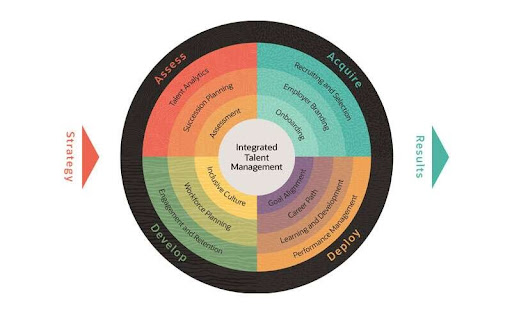Aside from talent acquisition, payroll, onboarding, employee relations, and the commonly attributed roles of HR, there is a role that many outside the realm of human resources might not be familiar with. Talent management.
What is talent management?
Talent management is a constant process that involves attracting and retaining high-quality employees, developing their skills, and continuously motivating and pushing them towards improvement.
Its primary purpose is to create a highly motivated workforce with a low staff turnover.
The implementation, however, differs from company to company. It requires a good strategy for it to be effective in an organisation. Simply having a human resources department doesn’t mean that you are managing your talent effectively.
Talent management encompasses a thorough process of acquiring and developing future talent.
What is the difference between talent acquisition and talent management?
Talent acquisition is the process of attracting and hiring good and qualified people.
On the other hand, talent management helps you train, develop, and retain these quality hires. If you attract and hire great employees but don’t invest in their development, you won’t be able to unleash their potential or retain them.
Talent acquisition is a subset of talent management. The management starts with the attraction and acquisition of qualified people and proceeds further to enable them to grow and thrive. This, in turn, improves talent retention.
You, therefore, cannot have one without the other. The overall talent management strategy needs to incorporate both.
Why is talent management important for organisations?
A company cannot thrive without its people. The talent at the company drives its business and growth. Without the right talent, a company risks poor customer satisfaction, low sales, lack of innovation, and bad company culture.
Without a good talent management strategy, a company risks a high staff turnover in addition to all the problems that come with poor talent.
Companies that have a good strategy will inevitably have a competitive advantage because of the investment in their employees. As a result, these companies identify internal candidates to fill key positions. This eventually relates to increasing talent retention rates, boosting morale to keep employees motivated, and helping them achieve their full potential.
These are the benefits of having a talent management strategy:
- Performance improvement: Top well-managed talent will always have better output than neglected talent. These employees are highly motivated, satisfied, knowledgeable, and team players.
- Competitive advantage: By hiring and developing talented employees, your organisation becomes better prepared to face changes and risks.
- Drives innovation: With the constant change in technology, talented employees will always find ways to leverage new tools to improve the company’s performance.
- Lower employee turnover: Employees that feel valued at a company and see plenty of avenues to grow are less likely to seek opportunities elsewhere.
- Improves teamwork: An effective strategy will build great, productive teams rather than a bunch of talented individuals.
- Strong employer branding: A great talent management strategy will brand your company as a great employer, attracting more talent in the future.
Research from UNC Kenan-Flagler Business School has demonstrated that companies that have a good talent management strategy have:
- 2x the revenue than those without talent management programs.
- 40% lower employee turnover.
- 38% higher employee engagement.
Talent management models

The talent management model involves four crucial steps.
In this order:
- Acquire – Employer branding and recruitment of talent.
- Deploy – Make sure they have the right training to meet business needs and continually track performance.
- Develop – Workforce planning, workplace culture, engagement, and retention practices.
- Assess – Talent analytics, succession planning, and assessments.
What is the talent management process?
Talent management is a continuous process of:
- Evaluating the company’s workforce needs.
- Attracting and employing the right talent to advance the company’s strategy.
- Managing the workforce, so people stay engaged and productive.
- Repeat.
HR, leadership, and technology industry analyst Josh Bersin recommends that companies use a specific process that includes:
1. Planning
Needless to say, it includes planning your talent strategy. This means taking into account numerous factors to anticipate labour needs. These include voluntary turnover rate, workforce demographics and succession planning, business priorities, and budget.
Workforce planning strategy involves identifying the skills that the company currently needs vs the strengths of the current staff. Additionally, it is equally important to nurture good performers for future roles.
2. Attracting
Actively seeking the right candidates for open positions is the role of recruiting specialists. They advertise on various job boards, encourage current employees to make referrals, and work with headhunters to find suitable candidates.
Recruiters then vet candidates, gather essential information, and pass the best applicants to the recruiting personnel.
Selecting and hiring the right candidates involves careful coordination among recruiting, human resources, finance, and the business function teams to develop attractive packages.
Once the offer is extended and accepted by a prospective employee, onboarding (typically an HR function) and training (a business function) begins.
3. Developing
Training the people you hire begins at onboarding. This further progresses to providing job-specific training, goal setting, and performance reviews. Beyond that, it extends to developing competencies that advance individuals in a way that’s aligned with business objectives.
4. Retaining
Retaining and engaging employees is more than awarding attractive compensations. Companies need to encourage managers to provide timely feedback to ensure their employees are helping in forwarding business goals. Furthermore, compensation should be tied to performance and aligned with business success.
5. Transitioning
It involves proactive succession planning and leadership development. Promising leaders are identified, moved into management roles, and provided with the development opportunities necessary for their progress in order to meet the needs of the organisation long-term.
Talent management strategies for 2022
2020 and 2021 redefined HR for many companies. Work from home, layoffs, online teamwork, etc., have been witnessed all over. New strategies need to be incorporated to fit the “new normal.”
Some of these include:
- Consider hybrid teams– Companies can incorporate contractors and freelancers to work with the permanent staff. This saves money and reduces turnover
- Encourage flexible frameworks– If possible, provide a flexible framework in which team members can accomplish critical goals and projects.
- Skill sets- Encourage recruitment of talent with multiple skill sets.
- Have a dynamic strategy– The times change very fast nowadays. Having a strategy that changes with the times can be helpful
- Incorporate more technology in the organisation’s day-to-day activities to fill skills gaps. For global organisations, or those having embraced work from home cultures, this may include virtual reality-based training.
- Create career development paths– Employees engage more with their work when they feel that their employer is committed to their growth and development.
- Mentorship– This has always been one of the most effective tools to improve employee performance, and in 2022, it will be no different.
- Make use of employee training tools– These will help you identify their performance gaps and give them immediate feedback. In the end, you’ll have better employees.
- Promote diversity and inclusion– This makes your organisation attractive to a wide range of talent, giving you the best employees. D&I strategies in the workplace are important to ensure a good working culture plus removing the unconscious biases within the company. Read more in our article on “Diversity and Inclusion in the Workplace.”
- Prioritise your employees- Having good internal recruitment structures will keep employee satisfaction high and, as a result, their performance too.
- Learn from past mistakes– Keep an eye out for issues that plagued your employees in the past and mitigate them before they grow into bigger problems.
- Employee recognition– If they don’t feel valued, they will look elsewhere for recognition leading to a high staff turnover. Valuing your employees for their efforts and showing it with rewards and positive feedback is a strong employee retention technique.
Conclusion
Talent management clearly needs to be included in every company’s human resources policy.
When carefully built and given room to evolve both organically and through constant continuous adjustment, a great talent management strategy can be one of your company’s greatest attributes.
The key is recognising how to reconcile the company’s needs with those of an ever-evolving workforce. Once done, it will naturally help to achieve a work environment that supports both team member growth and business success.
Author: David Simpson
Co-founder and Director of Learning and Development David Simpson, originally from Northern Ireland and with a background in psychology, has significantly impacted the learning and development landscape in Asia. In 2002, he co-founded Team Building Asia, one of Asia’s most successful team building companies, and he has been stimulating innovation in corporate training ever since. Co-founder of Growth Academy Asia, David challenges teams to reach their highest potential through experiential, interactive and immersive workshops with a meaningful business outcome.





